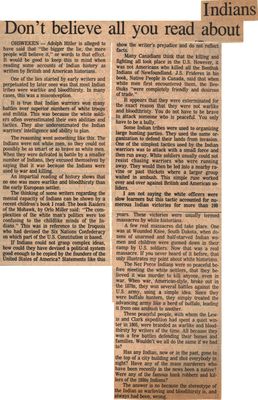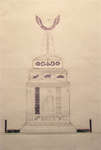"Don't Believe All You Read About Indians"
- Full Text
- Don't believe all you read about Indians
OHSWEKEN - Adolph Hitler is alleged to have said that "the bigger the lie, the more people will believe it," or words to that effect. It would be good to keep this in mind when reading some accounts of Indian history as written by British and American historians.
One of the lies started by early writers and perpetuated by later ones was that most Indian tribes were warlike and bloodthirsty. In many cases, this was a misconception.
It is true that Indian warriors won many battles over superior numbers of white troops and militia. This was because the white soldiers often overestimated their own abilities and tactics. They also underestimated the Indian warriors' intelligence and ability to plan.
The reasoning went something like this. The Indians were not white men, so they could not possibly be as smart or as brave as white men. When they were defeated in battle by a smaller number of Indians, they excused themselves by saying that it was because the Indians were used to war and killing.
An impartial reading of history shows that no one was more warlike and bloodthirsty than the early European settler.
The thinking of some writers regarding the mental capacity of Indians can be shown by a recent children's book I read. The book Raiders of the Mohawk, by Orlo Miller said: "The complexities of the white man's politics were too confusing to the childlike minds of the Indians." This was in reference to the Iroquois who had devised the Six Nations Confederacy on which part of the U.S. Constitution is based.
If Indians could not grasp complex ideas, how could they have devised a political system good enough to be copied by the founders of the United States of America? Statements like this show the writer's prejudice and do not reflect facts.
Many Canadians think that the killing and fighting all took place in the U.S. However, it was not Americans who killed all the Beothuk Indians of Newfoundland. J.S. Frideres in his book, Native People in Canada, said that when white men first encountered them, the Beothuks "were completely friendly and desirous of trade."
It appears that they were exterminated for the exact reason that they were not warlike and bloodthirsty. You do not have to be brave to attack someone who is peaceful. You only have to be a bully.
Some Indian tribes were used to organizing large hunting parties. They used the same organization to defend their lands from invasion. One of the simplest tactics used by the Indian warriors was to attack with a small force and then run away. White soldiers usually could not resist chasing warriors who were running away. They would then be led into a nearby ravine or past thickets where a larger group waited in ambush. This simple ruse worked over and over against British and American soldiers.
I am not saying the white officers were slow learners but this tactic accounted for numerous Indian victories for more than 100 years. These victories were usually termed massacres by white historians.
A few real massacres did take place. One was at Wounded Knee, South Dakota, when dozens of unarmed and half-starved Indian women and children were gunned down in their camp by U.S. soldiers. Now that was a real massacre. If you never heard of it before, that only illustrates my point about white historians.
The Nez Perce Indians were so peaceful before meeting the white settlers, that they believed it was murder to kill anyone, even in war. When war, American-style, broke out in the 1870s, they won several battles against the U.S. army, using a simple idea. Since they were buffalo hunters, they simply treated the advancing army like a herd of buffalo, leading it from one ambush to another.
These peaceful people, with whom the Lewis and Clark expedition had spent a quiet winter in 1805, were branded as warlike and bloodthirsty by writers of the time. All because they won a few battles defending their homes and families. Wouldn't we all do the same if we had to?
Has any Indian, now or in the past, gone to the top of a city building and shot everybody in sight? Have any of the mass murderers who have been recently in the news been a native? Were any of the famous bank robbers and killers of the 1930s Indians?
The answer is no because the stereotype of the Indian as warloving and bloodthirsty is, and always had been, wrong.
- Mystery Question
- Who is the author of this article and when was it published?[Please answer by clicking on the Comments tab]
- Media Type
- Newspaper
- Item Types
- Articles
- Clippings
- Description
- " Adolph Hitler is alleged to have said that "the bigger the lie, the more people will believe it," words to that effect. It would be good to keep this in mind when reading some accounts of Indian history as written by British and American historians."
- Subject(s)
- Personal Name(s)
- Hitler, Adoplh ; Miller, Orlo ; Frideres, J.S.
- Local identifier
- SNPL002270v00d
- Collection
- Scrapbook #1 by Janet Heaslip
- Language of Item
- English
- Geographic Coverage
-
-
Ontario, Canada
Latitude: 43.06681 Longitude: -80.11635
-
- Creative Commons licence
 [more details]
[more details]- Copyright Statement
- Public domain: Copyright has expired according to Canadian law. No restrictions on use.
- Copyright Holder
- Brantford Expositor
- Contact
- Six Nations Public LibraryEmail:info@snpl.ca
Website:
Agency street/mail address:1679 Chiefswood Rd
PO Box 149
Ohsweken, ON N0A 1M0
519-445-2954



